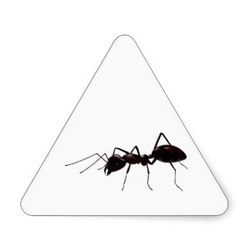An ant on a triangle
 An ant is on the vertex of a triangle. It can move 'left' with probability of
2
1
and 'right' with probability of
2
1
. Note that, the meaning of "moving left or right" is on the corresponding triangle's sides. The expected number of moves till it first reaches its starting point is
b
a
, where
a
and
b
are positive coprime integers. Calculate
a
+
b
.
An ant is on the vertex of a triangle. It can move 'left' with probability of
2
1
and 'right' with probability of
2
1
. Note that, the meaning of "moving left or right" is on the corresponding triangle's sides. The expected number of moves till it first reaches its starting point is
b
a
, where
a
and
b
are positive coprime integers. Calculate
a
+
b
.
The answer is 4.
This section requires Javascript.
You are seeing this because something didn't load right. We suggest you, (a) try
refreshing the page, (b) enabling javascript if it is disabled on your browser and,
finally, (c)
loading the
non-javascript version of this page
. We're sorry about the hassle.
4 solutions
Great approach!
Log in to reply
This is a general line of approach for solving problems involving the so-called "regeneration points".
This is a textbook example of when to use a Markov chain.
We define three states:
-
state 1 refers to the initial state, before the ant has moved from the initial vertex
-
state 2 refers to the state when the ant is on either of the two "non-initial" vertices
-
state 3 is an absorbing state, when the ant has returned to the initial vertex
The transition matrix, P is as follows:
P = ⎣ ⎡ 0 0 0 1 1 / 2 0 0 1 / 2 1 ⎦ ⎤
We define μ i as the expected number of moves from state i to the absorbing state (state 3). We would like to find μ 1 (the expected amount of time it takes to go from state 1 to state 3). Clearly μ 3 = 0 . For the other states (the "transient" states), μ i may be described as follows:
μ i = 1 + ∑ j = 1 m P i j ⋅ μ j
... where m = 3 is the total number of states in the Markov chain.
Using the values in the transition matrix, P , we find the following system of equations:
-
μ 1 = 1 + μ 2
-
μ 2 = 1 + 2 1 μ 2 + 2 1 μ 3
We know that μ 3 = 0 , since state 3 is an absorbing state. This gives us two equations with two unknowns:
-
μ 1 = 1 + μ 2
-
μ 2 = 1 + 2 1 μ 2
We can solve to find μ 2 = 2 and μ 1 = 3 .
The answer ( μ 1 ) is 3 (a = 3, b = 1, user enters 4).
Note that this solution is essentially the same as Abhishek's. I only include the Markov-specific terminology, which is useful when solving more complicated problems.
Let P(E) be the expected number of moves.
P(L) be the expected number of moves after the ant moves left.
P(R) be the expected number of moves after the ant moves right.
P(LR) be the expected number of moves after the ant moves left than right and so on.
Then P(E)=1/2 P(R) + 1/2 P(L)
Note that the expected number of moves after moving right and left is the same.
Then P(E)=P(L)=P(R)
P(L)=1/2 P(LR)+ 1/2 P(LL) => P(LR) means the ant is on the original side.
Since LR means that the ant has made two move, P(E)= 1/2 (2) +1/2 P(LL)
1/2 P(LL) = 1/4 P(LLR) +1/4 P(LLL)=1/4 P(LLR)+ 1/4 (3)
P(E) = 1/2 (2) + 1/4 (3) + 1/4 P(LLR)
Then continuing this, we get a summation tending to infinity.
S= 2 2 + 4 3 + 8 4 + 1 6 5 + . . .
2S= 1 2 + 2 3 + 4 4 + 8 5 + . . .
S= 2 + 2 1 + 4 1 + 8 1 + 1 6 1 + . . . = 1 3
3 + 1 = 4
Can someone tell is my approach right?New in here 3 Days
So the probability of the ant to get to the starting point in 2 moves is 2*1/(2^2) and multiply it to number of moves we get a infinite sequence as
Summation (n/2^n )*2 till infinity from n=2
Solving this we get 3
So the answer is 3/1 and hence a+b=4
Label the vertices of the triangle by a , b , c and assume that the ant was at vertex a initially. Let N ( b ) and N ( c ) denote the expected number of moves to reach vertex a starting from vertices b and c respectively. Hence we have the following equation : N ( b ) = 2 1 ( 1 ) + 2 1 ( 1 + N ( c ) ) and N ( c ) = 2 1 ( 1 ) + 2 1 ( 1 + N ( b ) ) . Solving these two, we have N ( b ) = N ( c ) = 2 . Since after the first move, the ant reaches either vertex a or b (with equal probability), the expected number of moves till it reaches the vertex a again is 1 + 2 = 3 .